How to Put Wayne Krantz's Open-String Chord Voicing Prowess to Work
Embrace the vibrancy of open strings and give your playing an extra melodic dynamic.

It's safe to say your first moments with a guitar probably involved one or more open strings, courtesy of the handful of 1st-position open chords (a.k.a. cowboy chords) that we all became acquainted with early on.
Stalwarts such as open E, C, and G shapes were reasonably playable, but even better, they sounded full and lively. As you started to learn an assemblage of tunes from your favorite bands and players, you discovered that open chords, as well as open strings in general, are everywhere.
Here’s why: There’s nary a note on your guitar that sounds as full and vibrant as an open string. Go further down the open-string rabbit hole and you’ll find other benefits they provide, such as giving your playing a more modern sound, with added depth and color.
Some of my favorite ways to use open strings to these ends were gleaned from one of my all-time favorite guitarists, the great Wayne Krantz. If you’re new to Krantz, allow me to remedy that.
He is a musical beacon of light among forward-thinking guitarists whose passion is improvised music centered on the deepest of pockets. While Krantz has a distinguished résumé of sideman work with various artists, such as Steely Dan, Michael Brecker, Billy Cobham, Leni Stern, and others, his impact is more realized through his own work.
Jumping onto the scene as a leader with his 1990 album, Signals, it quickly became evident that Krantz had a signature six-string voice. Long to Be Loose from 1993 confirmed that notion, featuring masterful compositions that showcase the guitarist’s deft approach to harmony and syncopated rhythms, creatively supported by bassist Lincoln Goines and drummer Zach Danziger.
These offerings, as well as Krantz’s 1995 live album, 2 Drink Minimum, which is regarded by many modern improvising musicians as a go-to desert island disc, are also brimming with novel approaches to the use of open strings.
Perpetually moving ahead, Krantz went on to recruit bassist Tim Lefebvre and drummer Keith Carlock at a time when they were young players new to the scene. This trio’s work, namely through Krantz's fabled Thursday-night residency at the 55 Bar in New York City, solidified all three musicians as some of today’s most important purveyors of improvisation-driven music on their respective axes.
After documenting this group several times, between Greenwich Mean (1999) and Krantz Carlock Lefebvre (2009), Krantz has since released several acclaimed works that feature all-star casts and showcase his uniquely seductive playing. To date, the guitarist’s recorded output, from Signals to his latest set, 2020’s Write Out of Your Head, offers many fine examples of how he inventively employs open strings in ways that demand your attention.
Let’s begin our look into Krantz’s distinctive approach to using open strings with a trio of common riffs that are coupled with Krantz-inspired ideas, inspired by a solo piece on Signals called “One of Two.”
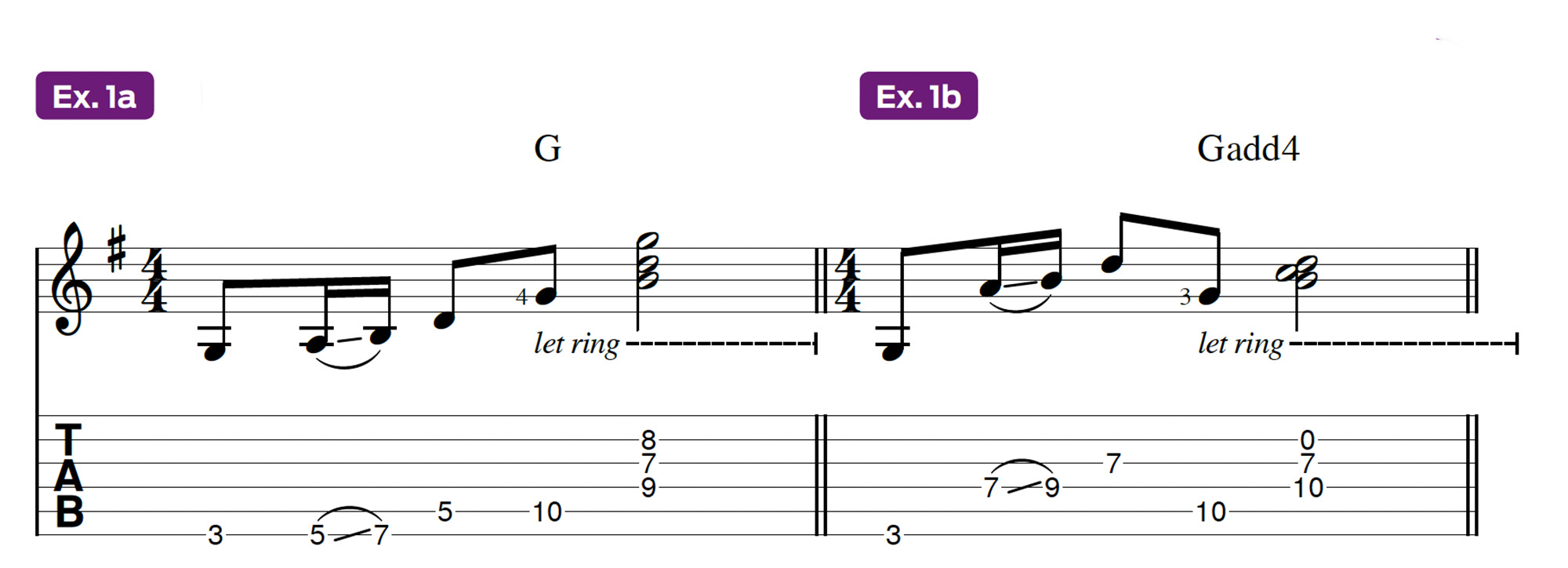
In Example 1a we have a Jimi Hendrix–like multipositional move up a G major arpeggio (G, B, D), en route to a 1st-inversion G chord voicing (low to high: B, D, G).
Example 1b first demonstrates how Krantz would enhance a stock riff by supplanting some of it up an octave. The musical gold, however, resides in the transformative Gadd4 cluster voicing that incorporates the use of the open B string.
With the 3rd of the chord (B) now played open, this allows the added 4th (C) to be fretted on the 4th string. The result is a mouth-watering harmonic morsel containing a nested minor-2nd interval, between the 3rd and 4th of the chord (B and C). Additional buried treasure is the timbral seasoning that the open B string imparts.
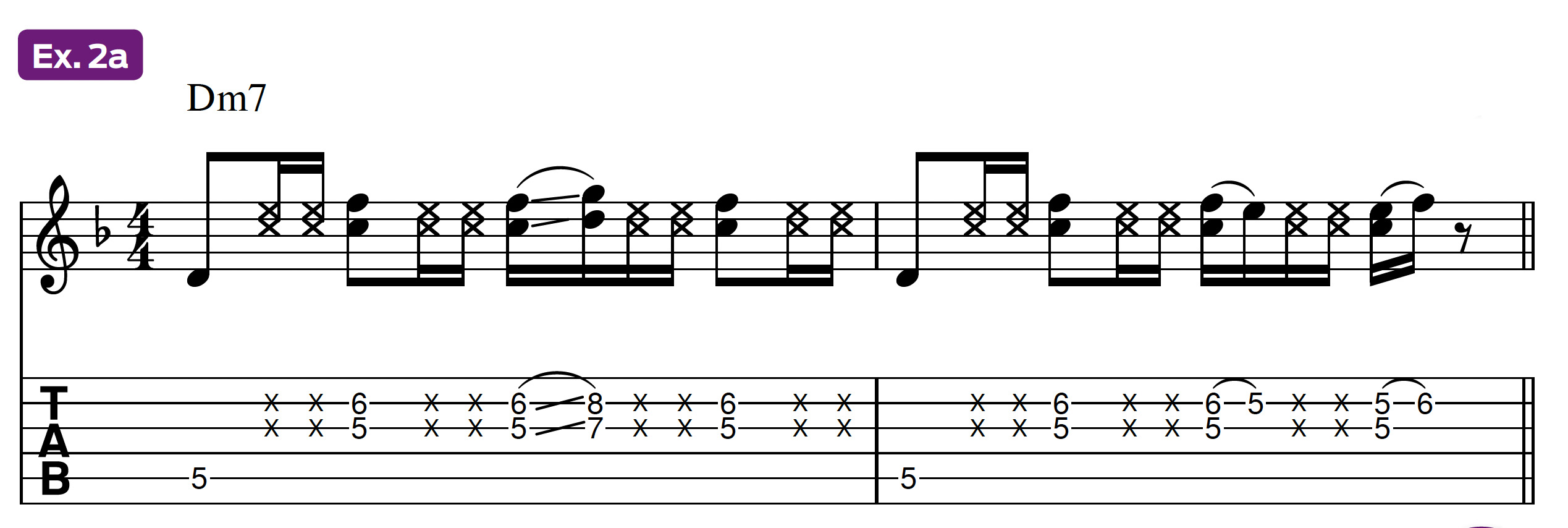
Examples 2a and 2b transform a stock two-bar funk vamp based on a Dm7 chord (D, F, A, C) into a head-snapping syncopated tour de force. Krantz generally eschews the funk rhythm staple of percussive “scratch strumming” that helps drive Example 2a and will often replace it with invigorating syncopated ricochet action between downstroke riffing on the lower strings and laying down novel-sounding voicings on the higher strings.
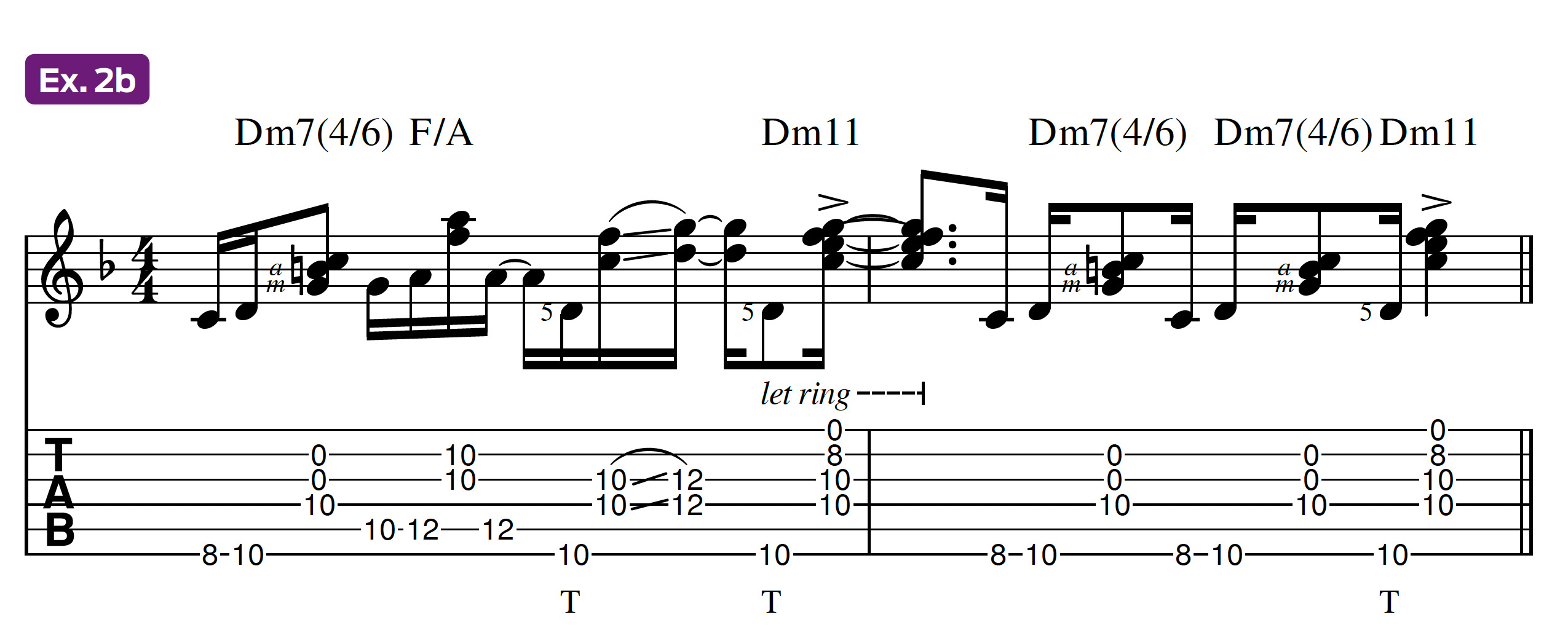
To play the notes on the D, G, and B strings on the upbeat of beat 1 of Example 2b, use your fret-hand pinkie to grab the 10th-fret C while you employ hybrid picking with the pick hand. As the pick plays the fretted C, your middle and ring fingers pick the open G and B strings, respectively.
Together with the D root on the 6th string that precedes it, this note combination and cluster conveys a lush Dm7(4/6) sound. Continue to use these hybrid picking assignments per adjacent strings throughout the example, including the sliding perfect 4ths, which require thumb fretting for that same tonic D note.
Keep the thumb there and use a downstroke for the notes on the top four strings for what equates to a snappy Dm11 voicing. The various techniques applied here can serve as a general guide to playing the examples that follow.
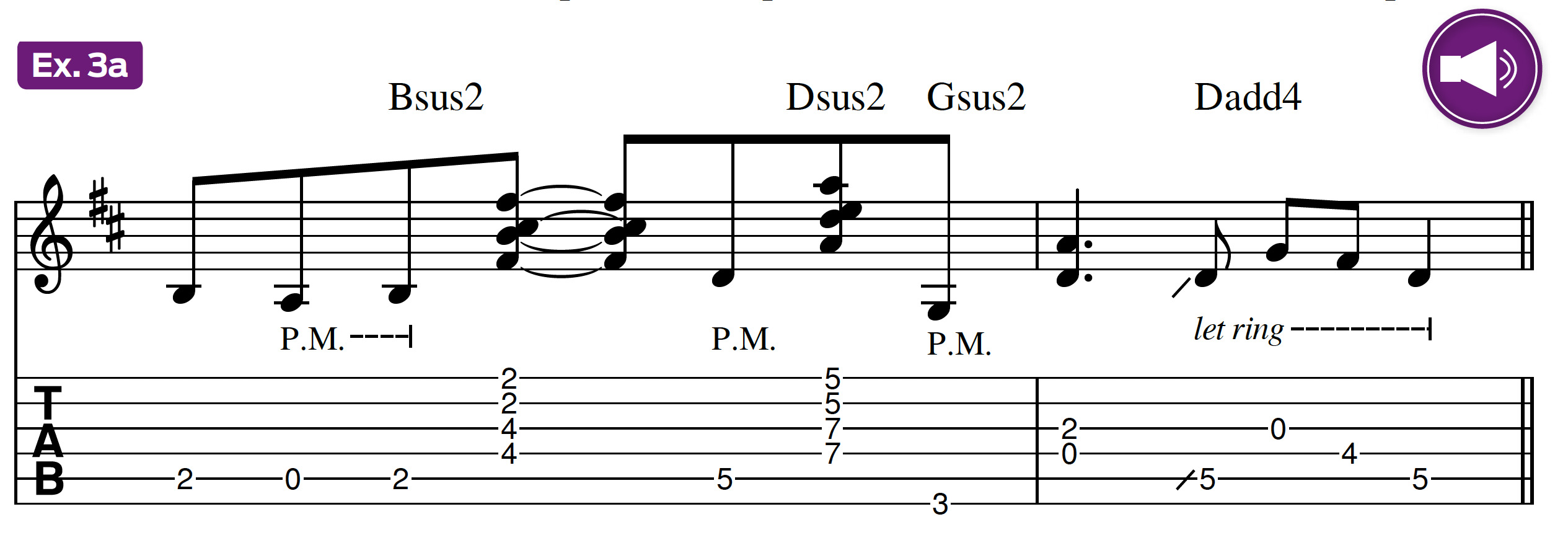
While the i - bIII - bVI progression of suspended chords in the key of B minor (Bsus4 - Dsus2 - Gsus2) in Example 3a follows a straight eighth-note groove and concludes with a time-honored arpeggiation move, Example 3b is a rhythm section’s syncopated dream come true.
It’s also an example of open strings bolstering not only chords but riffs too. For each syncopated three-note motif that precedes the chords, pick downstrokes for the fretted notes and use a hybrid-picked accent for the open-string notes. All chords should be played with laser-precise downstrokes.
Be sure to arch your fretting fingers high, so that the open high E string in the Bm(add 4)/F# and Dadd2/C# voicings and the open G in the Gmaj7 ring out as intended.
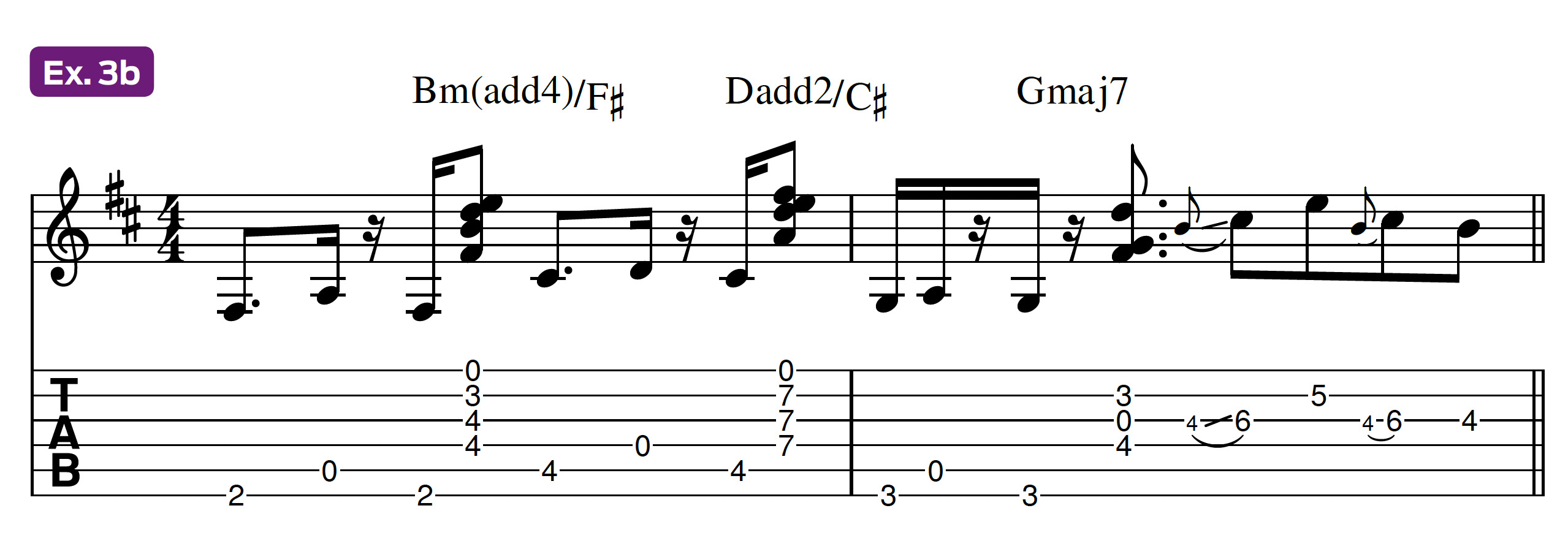
Once again, notice how the employment of open strings here facilitates the use of 2nd intervals, with major 2nds on the top of the first two chords and a minor 2nd occurring within the Gmaj7 voicing.
For the single notes at the end of bar 2, use downstrokes on the G string and fingerpick the E note on the B string. Putting it all together, the use of downstrokes and hybrid picking, along with legato grace-note slides, is signature Krantz.
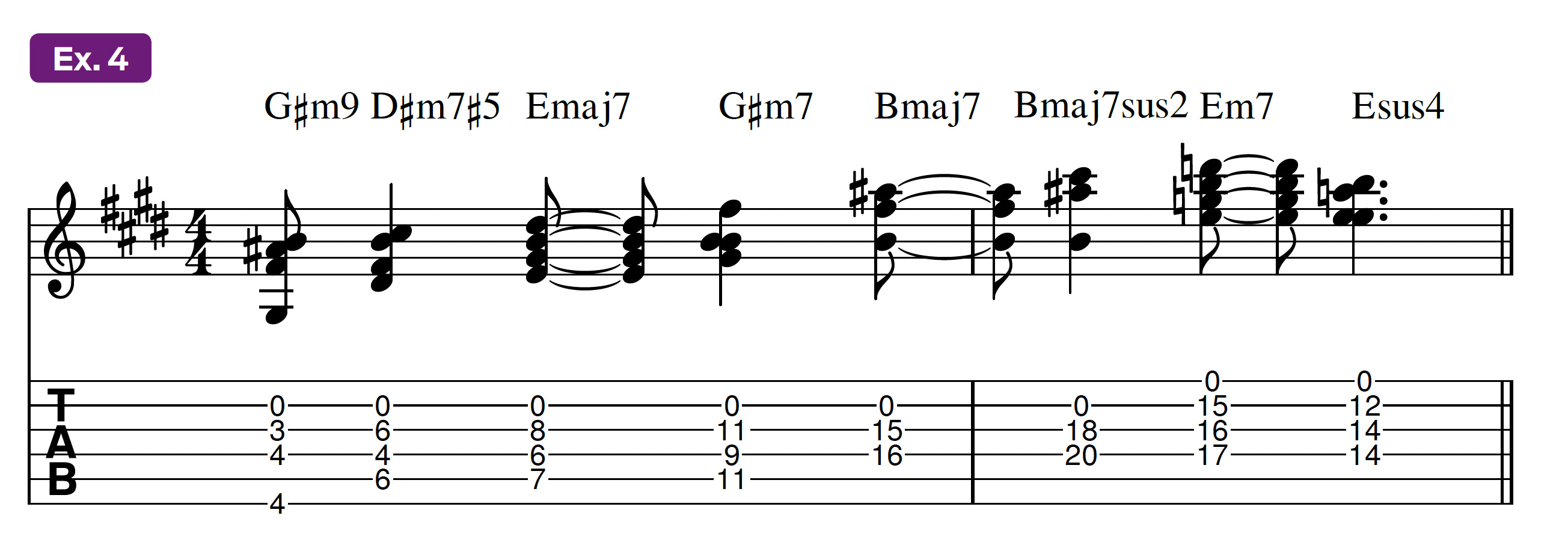
Also informed by Krantz’s riffing in “One of Two,” Example 4 reveals a reworking of an ascending array of chords that demonstrates how the guitarist will use an open string as a common tone among changing chords. Starting with the G#m9, the open B string, and later the open high E, serve as both a constant pitch and an almost angelic tonal element.
Speaking to the latter, combined with low-wattage amps set to the brink of breakup and Krantz's commitment to single-coil pickups, open strings seem to thrive in his hands, even more so when hybrid picked.
Starting with the Bmaj7 chord at the end of bar 1, notice that the open-string notes become the roots. As you work your way up the neck here, the open string will become the lowest note in the chord and often serve as the root, even when it’s physically in the middle or at the top of the voicing.
Keep this in mind when considering my chord naming going forward. At the same time, looking at the notation and seeing the actual pitch hierarchy will help dispel possible confusion.
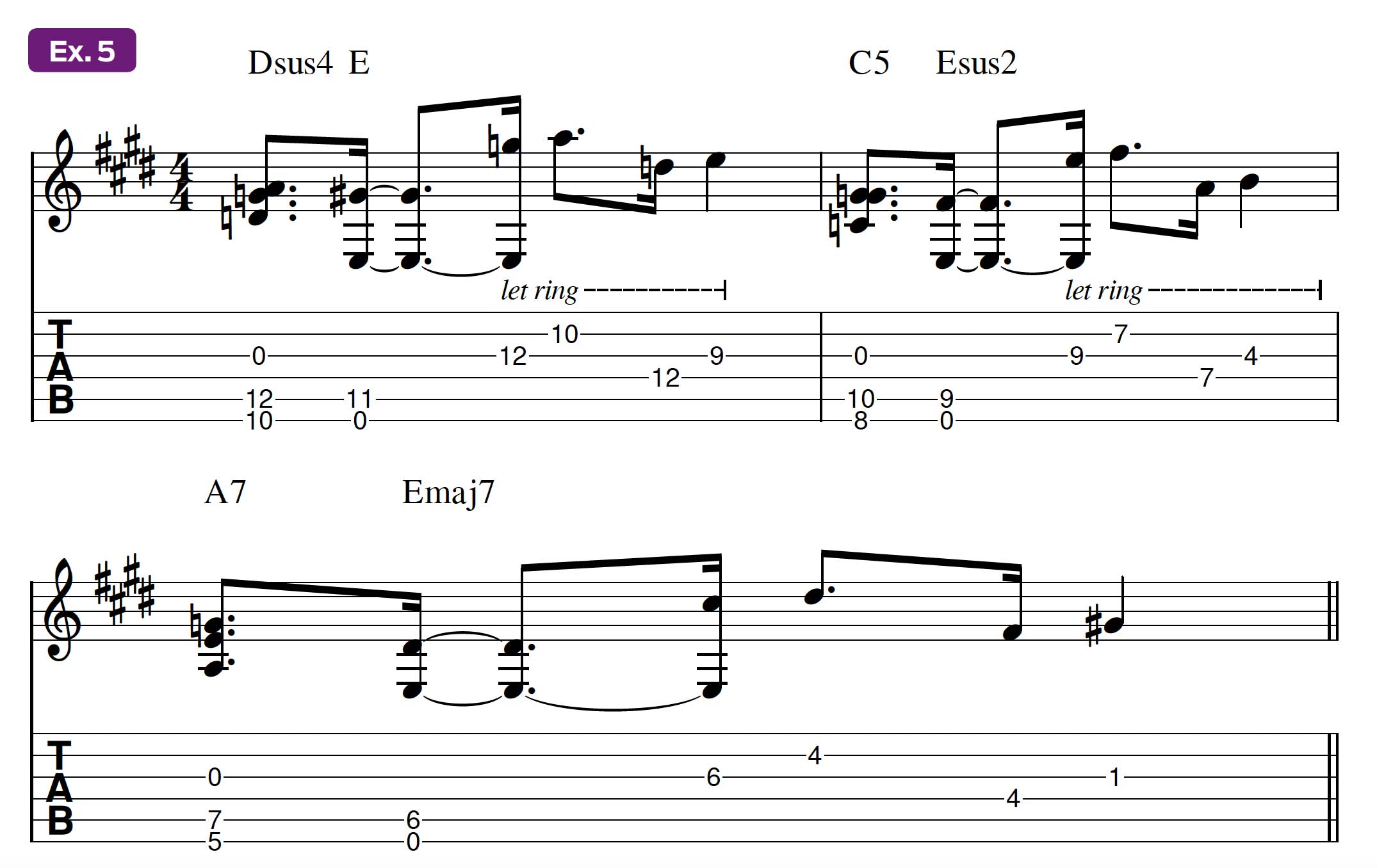
Example 5 is inspired by what Krantz plays in “Worn Torn Johnny,” from Krantz Carlock Lefebvre. Here, you see a consistent open G string color each power chord a different shade while a recurring open low E creates brooding dyads and hovers over the following motives.
Though they’re not nested in the chords, the ever-present 2nd intervals are what make up those following two-note melodic statements.
For added Krantz effect, let them ring together as best as you can. And for the smoothest transition from the chords to the single notes, fret the first single note of each bar with your pinkie.
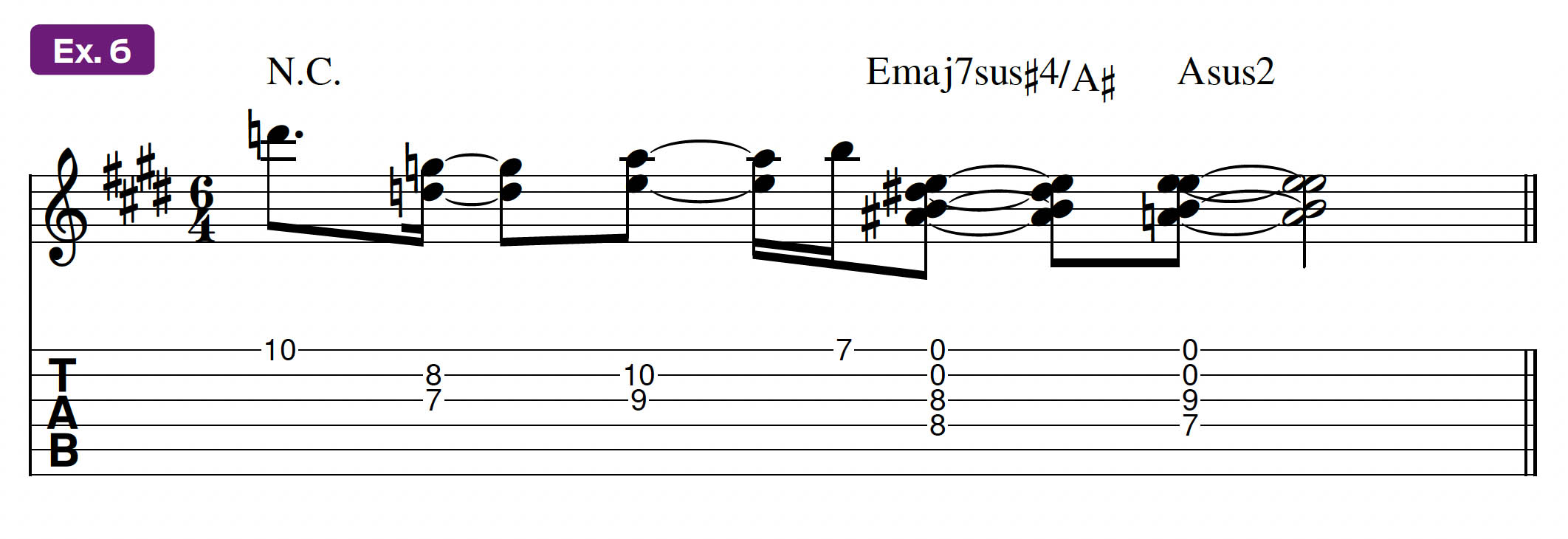
When it comes to open strings, we all like to bask in the chime-y goodness of the open B and high E, when played in conjunction with fretted notes on the lower strings.
That said, in Wayne’s world, you’ll discover an innovative perspective on this approach, such as this broken-up iteration of a moment from another KCL track called “Jeff Beck” in Example 6. Check out the contrary-motion counterpoint between the fretted notes of Emaj7sus#4/A# and Asus2.
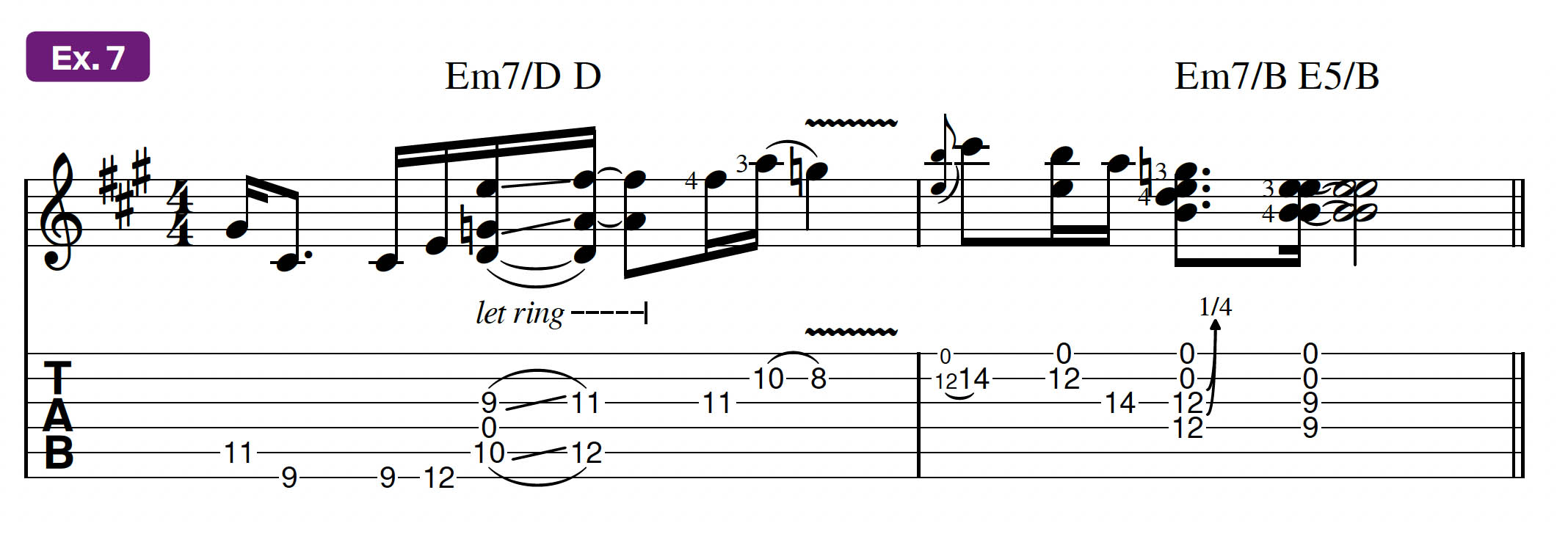
Example 7 emulates another taste from the same tune, where Krantz goes for a static perfect-4th shape on the lower fretted notes of the chords Em7/B and E5/B. Notice in bar 2 the slight, quarter-tone bend, or “curl,” on the A-D dyad in the Em7/B.
Looking back to the Em7/D and D chords in bar 1, you’ll see an open string surrounded by fretted notes. This exemplifies Krantz's flagship use of open strings within chords.
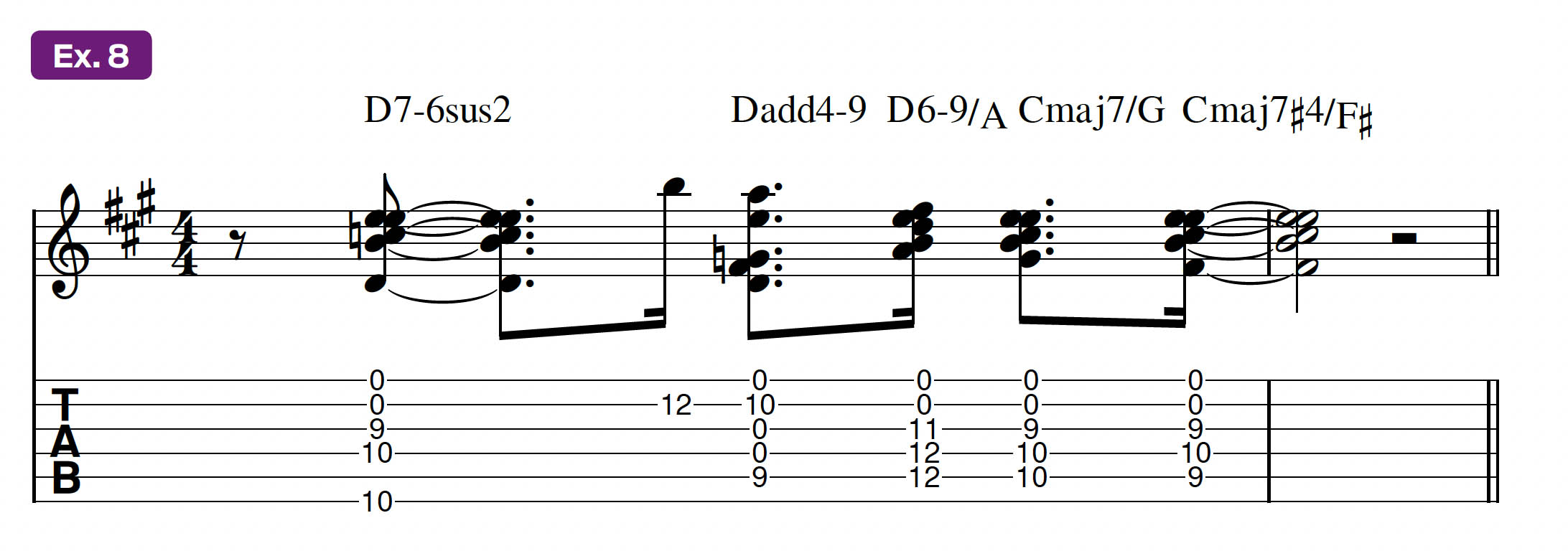
Shifting to Long to Be Loose, Example 8 is reminiscent of a passage in the album’s 10th track that further promotes this procedure, this time as part of thoughtfully voiced five-note chords.

Example 9 offers additional demonstrations inspired by the same tune with added considerations. In bar 1, there’s arpeggiation action on the open strings of the F#m7add4 before you downstroke the open-string-enhanced D6-9.
Bar 2 gives way to more three-note open-string harmonic sandwiches before moving ahead to two more Krantz trademarks. There’s the descending melodic perfect 4th (D-A) preceding a chord (A/E), along with an open-string-laced A7 voicing with a fretted major 3rd on the lowest strings.
Inspired by solo pieces like “One of Two,” this lesson’s final offering, Example 10, sets the ideas and techniques presented throughout this lesson in a call-and-response conversation with a riff that’s also informed by “It’s No Fun Not to Like Pop” (Krantz Carlock Lefebvre).

If this concentrated look into one of the several fascinating aspects of Wayne Krantz’s guitar style is your introduction to him as a player, I encourage you to investigate him further and take a deep dive into his recorded works, both as a leader and sideman, as well as his tell-all tome, An Improviser’s OS.
At the very least, it will make you think, but I predict the world of Wayne Krantz will do much more and provide some welcomed musical inspiration, just as it did for me.
Get The Pick Newsletter
All the latest guitar news, interviews, lessons, reviews, deals and more, direct to your inbox!
Chris Buono is a top-selling TrueFire Artist with nearly 50 instructional videos, and a featured instructor on guitarinstructor.com. Bookending his years as a Berklee professor, he authored eight books, including the popular Guitarist’s Guide to Music Reading and his most recent publication, How to Play Outside Guitar Licks.
“Write for five minutes a day. I mean, who can’t manage that?” Mike Stern's top five guitar tips include one simple fix to help you develop your personal guitar style
"It’s like you’re making a statement. And you never know where it’ll lead." Pete Thorn shares the tip that convinced Joe Satriani he was the right guitarist for the SatchVai Band











